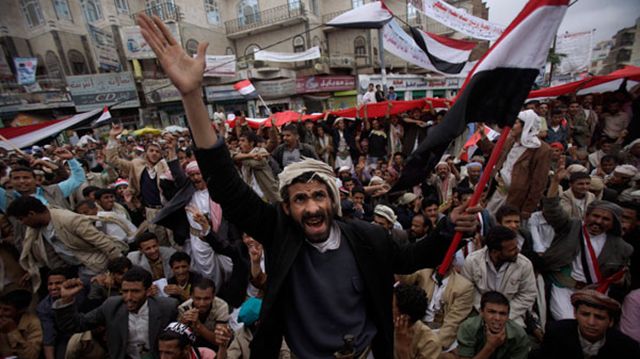
Al-Qaeda in the Arabian Peninsula and the Protests in Yemen
Publication: Terrorism Monitor Volume: 9 Issue: 10
By:

As calls intensify for the resignation of Ali Abdullah Salih, Yemen’s president of 32 years, the immediate impact of the political unrest on al-Qaeda in the Arabian Peninsula (AQAP) remains unclear. Thus far, the turbulence appears to have had minimal impact on the group ideologically, logistically or strategically. Through Malahim Media, AQAP issued a belated commentary on the Tunisian revolution and touched broadly on the wave of Arab uprisings, yet it has remained silent concerning the domestic upheaval within Yemen. The group’s position on the political periphery denotes its limited involvement in the current uprising and implies that it will likely utilize this period of decreased attention to improve its position against whomever remains standing when the dust settles in Sana’a.
One month after Tunisia’s Jasmine Revolution, AQAP released the latest version of its bimonthly Arabic-language online magazine, Sada Al Malahim. Of 52 pages, only one was dedicated solely to the events in Tunisia. In the opening editorial, entitled “To our people in Tunisia, do not lose what has been gained,” the author congratulates Tunisians on their “jihad,” which he says will return the country to Islamic rule and “send secularism and democracy to hell” (Sada Al Malahim, February 15).
Ignoring the dominant secular and democratic themes of the Tunisian uprising, AQAP’s revisionist history places the revolution into a broader jihadist narrative. It claims victory for Islamists and urges the Tunisian public to make use of the opportunity to create a system governed not by man’s law but by God’s (Sada Al Malahim, February 15).
AQAP’s second reference to the revolutions came in an audio statement entitled “Ibn Ali and Ibn Saud,” in which Shaykh Ibrahim al-Rubaysh broadly encourages revolt against Arab dictators, but warns that their replacement with anything short of Shari’a is bound to see problems of chaos and corruption continue. As the title suggests, much of the ten-minute statement is spent chastising the Saudi king for harboring the former Tunisian president and criticizing the Saudi religious community for its silence. Al-Rubaysh, a former Guantanamo detainee and one of AQAP’s most prolific ideologues, continues to stress the importance of choosing the proper replacement for fallen leaders, imploring the public to take advantage of the opportunity before them (Malahim Media, February 26).
While AQAP may share with Yemen’s opposition protesters a desire to see Salih’s regime fall, the group seems to be devoting little attention to the Yemeni uprising. Furthermore, the movement most capable of ousting the current government is pushing for legitimate democracy, not violent extremism. In response to the popular calls for a new transparency, Salih and his government have been brandishing their own democratic credentials (Saba News, February 26). In this political battle, there is no winning side for AQAP, which is likely planning for the future instead of trying to capitalize on the existing revolutionary politics.
Throughout the past year, AQAP has carried out attacks that have increased recruitment and expanded its base among specific populations. With anti-regime demonstrators calling primarily for democracy, AQAP is unlikely to gain new members from today’s pool of protesters. Its recent declaration of war against the northern Zaydi Shi’a Houthi movement appears to be a far more important milestone in terms of expanding AQAP’s range. Three articles in the latest issue of Sada Al Malahim dealt with the Houthis and the situation in Saada governorate. AQAP’s war on the Houthis, announced between the revolutions of Tunisia and Egypt, serves dual purposes in that it attacks ideological enemies and simultaneously builds support among the northern Sunni tribes centered in al-Jawf (Malahim Media, January 28).
Following a ceasefire declared by President Salih in February 2010, the Houthis retained control of checkpoints and prisoners captured during the sixth Saada war, leading to escalating tensions with the surrounding tribes. Skirmishes between the Houthis and the tribes that fought alongside the government prior to the ceasefire have continued ever since (al-Masdar, January 17). AQAP’s successful attacks on the Houthis in late 2010 and subsequent rhetorical emphasis on the group have sent a clear message that AQAP intends to continue assisting al-Jawf’s Sunnis and capitalize on the sentiment that the tribes were abandoned by the government (Sada Al Malahim, January 3).
According to Shaykh Abdullah al-Jumaili of al-Jawf, that tactic is working. In a February 21 interview the shaykh stated that the outrage stemming from the destruction of farms and schools during the last war with the Houthis, combined with lack of development, an 80% unemployment rate and an abundance of arms, has created fertile ground for AQAP recruitment. “Right now, I see young people joining al-Qaeda,” said the shaykh. “They don’t have opportunities to work and now they’re looking for someone to feed them. They’ll be with whoever takes care of them.” [1]
Meanwhile, AQAP’s stronghold in southern Yemen appears unaffected by current political turmoil. In the month prior to the January 14 departure of Tunisia’s Zine El Abidine Ben Ali, the group was suspected in six attacks targeting security officials, killing 19 people. As Yemeni protests gained traction the following month, AQAP was suspected of involvement in five attacks in the provinces of Abyan and Mareb, killing seven. In the remainder of February, as protests throughout the country swelled to their largest numbers, three further AQAP attacks claimed three lives. While the number of deaths has declined, the better indicator of organizational ability, attacks staged, remained largely unchanged.
In the aftermath of the revolutions in Tunisia and Egypt, scholars argued that should those countries build transparent democratic governments and create opportunities for the growing middle classes, they may provide a potent antidote to Islamic extremism. By increasing their citizens’ stake in the system, Tunisia and Egypt may be able to lessen the appeal of extremist groups by providing alternatives. But those countries have robust economies that have the potential to improve the quality of life of their peoples. As President Salih frequently says these days, “Yemen is not Tunisia. Yemen is not Egypt.”
To compare, Egypt’s 2010 GDP is estimated at $500 billion, Tunisia’s at $100 billion and Yemen’s at $60 billion. Yemen has more than double the population of Tunisia, and according to the director of economic integration at the Gulf Cooperation Council (GCC), is facing economic collapse within two years (al-Sahwa, January 13).
Whether democratic reforms come from the current government or the next, the continuing frailty of Yemen’s economy and diminishing oil and water reserves means such reforms will pose little threat to AQAP. Regardless of who is at the helm of the country, Yemen will not soon be in a position to offer a drastically better future to Yemenis, 35% of whom are unemployed and 40% of whom live below the poverty line.
Given that a potential revolution is unlikely to drastically change the environment in which AQAP operates in the short term, its silence on the events unfolding in Yemen today appears to be part of a strategy for growth tomorrow.
Note:
1. Author’s interview with Shaykh Abdullah al-Jumaili, Sana’a, February 21.





